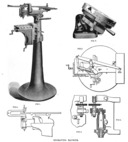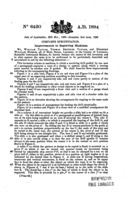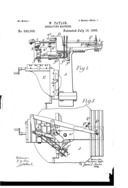Taylor, Taylor & Hobson. Leicester, England. (N.B. the machine is a "Taylor-Hobson" while the company was "Taylor, Taylor & Hobson.") Historically, the firm was best known for precision optics (e.g., Cooke brand photographic lenses); pantograph engraving machines came in as an ancillary activity.
1886. Founded by William Taylor and Thomas Smithies Taylor.
1887. Herbert William Hobson joins. (Source: Taylor-Hobson website: http://www.taylor-hobson.com/history.html . N.B., the website of the current Taylor-Hobson firm actually says "W.S.H. Hobson," but the 1894 GB patent, No. 6,420 of that year, issued to the three principals in the firm, clearly says "Herbert William Hobson.") Originally, they were optical instrument makers (Source: Cooke Optics website: http://www.cookeoptics.com/cooke.nsf/history/1890s.htm )
1894. Licensed the "Cooke Triplet" camera lens from T. Cooke & Sons (makers of astronomical telescopes). Curiously, this lens had been designed by Dennis Taylor, who was no relation to W. Taylor or T.S. Taylor. (Source: Cooke Optics website: http://www.cookeoptics.com/cooke.nsf/history/1890s.htm .) Continued production of camera lenses often using the Cooke brand name.
1894. Issued GB patent No. 6,420 of 1894 (later US 542,902 (1895)) for an engraving machine. This patent presents an interesting terminus ante quem. To me the distinctive feature of a Taylor-Hobson style machine (and the Gorton machines derived from it) is the separation of the support for the cutting spindle from the guiding structure of the pantograph. This allows the spindle to be held on a relatively substantial pivoting arm while the pantograph itself can be much lighter (and presumably more sensitive). This may be compared, for example, to the method of the Deckel where both functions are combined in the same set of arms. The 1894 Taylor-Hobson patent describes such a machine with separate cutting spindle and pantograph arms, but it does not claim that feature. This suggests that this arrangement already existed at the time. What, then, was the origin of this arrangement?
1930s. Company controlled by Bell & Howell. (Source: Wikipedia; verify and get further info.)
1946. The Rank Organization PLC purchases Taylor, Taylor and Hobson (and therefore also their subsidiary, Cooke Optics). Source: "Lens Buff Zooms In To Save Optics Firm," an article by Charles Goldsmith for the Wall Street Journal, 2000-03-23. Presented by Cooke Optics at: http://www.cookeoptics.com/cooke.nsf/news/lens_buff_saves_optics.html.
1996. Shroeder Ventures acquires "Taylor Hobson" [sic] from the Rank Organization. Source: http://www.taylor-hobson.com/history.html, accessed 2011-07-15. The firm continues as a manufacturer of precision metrology equipment.
1998. Cooke Optics became an independent company. (Source: Cooke Optics website: http://www.cookeoptics.com/cooke.nsf/history/1990s.htm ); Wikipedia suggests that this was a management buy-out of the Cooke Optics division.

Instructions, Model A
Taylor-Hobson Model 'A' Bench Engraving Machine. (Leicester, England: Taylor, Taylor & Hobson, Ltd., [no date, but between 1946 and 1996]). The Model A is a smaller, bench-mounted machine with a fixed worktable.
A digitization of this manual is online in the "Files" section of the Yahoo! "Pantograph-Engravers" group.

Instructions, C, CB, F (1930)
The Taylor-Hobson Engraving Machines, Models "C," "CB" and "F," Instructions To Be Handed to the Operator . (Leicester, England: Taylor, Taylor & Hobson, Ltd., 1930.)
Not reprinted here because due current US copyright law this document is in copyright in the US for 95 years from its publication date (unknown, of course) even if/when it enters the public domain in the UK.

"Improved Cutters" Flyer (ca. 1930)
"Improved Cutters for Taylor-Hobson Engraving Machines." (Leicester, England: Taylor, Taylor & Hobson, Ltd., [no date, but circa 1930]) This was enclosed in the The Taylor-Hobson Engraving Machines, Models "C," "CB" and "F," Instructions To Be Handed to the Operator (1930), above
Not reprinted here because due current US copyright law this document is in copyright in the US for 95 years from its publication date (unknown, of course) even if/when it enters the public domain in the UK.

Instructions, C, CB, CX, CXL
Taylor-Hobson Models C - CB - CX - CXL Engraving Machines: Assembly and Operating Instructions . (Leicester, England: Taylor, Taylor & Hobson, Ltd., March 1950.)
A digitization of at least some of the pages of this manual (together with some of the undated Model D manual, 17-7 (see below), presented in a most confusing page order, appears on the "Metal Illness" website (http://www.metalillness.com, which redirects to http://www.bbssystem.com/) at: http://www.bbssystem.com/manuals/taylor-hobson-engraver-mods-c-cb-cx-cxl.pdf.

Instructions, D
Operator's Handbook: Taylor-Hobson Model D Pantograph Machine (Leicester, England: Taylor, Taylor & Hobson, Ltd., [no date, but between 1946 and 1996].) Document ID: 17-7.
A digitization of at least some of the pages of this manual appears in the same PDF as the digitization of the Taylor-Hobson Models C - CB - CX - CXL Engraving Machines: Assembly and Operating Instructions , noted above .

Scientific American Supplement (1901)
Scientific American Supplement. Volume 52, Whole No. 1337. Pages 21426-21427. "[Taylor-Hobson] Engraving Machine."
This volume of Scientific American Supplement has been digitized by Google from the University of Michigan copy and is available both via Google Books and The Hathi Trust. The link here is to an extract of the two pages with the Taylor-Hobson article, assembled from images from The Hathi Trust version.

GB Patent 6420 of 1894
GB patent No. 6,420 of 1894. Accepted 1894-06-02. Application filed 1894-03-30. William Taylor, Thomas Smithies Taylor, and Herbert William Hobson. "Improvements in Engraving Machines."

US Patent 542,902 (1895)
US patent 542,902. Issued 1895-07-16. Filed 1894-05-28 as application serial number 512,790. William Taylor, assignor of 2/3 to Thomas Smithies Taylor and Herbert William Hobson. "Engraving Machine."
US patent specifications are in the public domain.
The UK Crown Copyright on the 1894 Taylor, Taylor, and Hobson patent reproduced here has expired; it is now in the public domain.
All portions of this document not noted otherwise are Copyright © 2011, 2022 by David M. MacMillan.
Circuitous Root is a Registered Trademark of David M. MacMillan.
This work is licensed under the Creative Commons "Attribution - ShareAlike" license, version 4.0 International. See http://creativecommons.org/licenses/by-sa/4.0/ for its terms.
Presented originally by Circuitous Root®